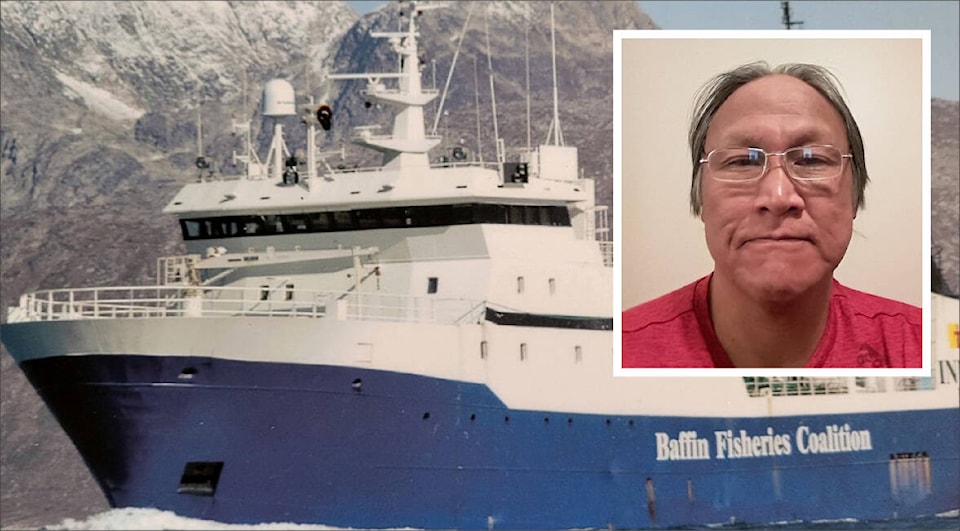Fishing has helped sustain Inuit for generations.
Commercial fishing has allowed Nunavummiut like Enoo Bell and Kyle Aglukkaq to earn a good living, although it comes with sacrifices.
Bell has been a commercial fisher since the late 1980s when he took a four-day “crash course” in Iqaluit that allowed him to jump into the industry. That was back when regulations weren’t so stringent, he recalled.
He’s been on hundreds of trips lasting from 15 to 25 days to harvest shrimp and turbot. He didn’t see his family for more than three months on one occasion in the early 1990s.
“It’s hard to leave. Sometimes out there (you think), ‘Why am I here?’ And they need me at home right now — the Ski-Doo needs fixing and the four-wheeler won’t start. You know, stuff like that” he said.
On the other hand, his employer takes very good care of him and he’s pleased that Inuit have increasingly become rights-holders within the commercial fishing industry.
His commercial fishing career has taken him to places like Greenland, Iceland, the Faroe Islands, Denmark, Norway and England.
The year-round journeys for the 30 crew aboard the Baffin Fisheries-owned MV Sivulliq — one of six boats that Bell has worked on over his career — start from Bay Roberts, Nfld., meaning Bell flies from his home community of Kinngait to Iqaluit, Ottawa, Toronto, Halifax and then to St. John’s.
A typical 12-hour workday is spent over two six-hour shifts emptying shrimp from the vessel’s ramp or packing 5-kilogram boxes or 18-kilogram bags of the crustaceans. The destination for the seafood has varied over the years but the fish has been shipped to places such as Japan, Italy, Denmark, Korea, and China.
When not working, sleeping or eating, there’s time aboard the fishing vessels to watch cable television, surf the internet or send emails, Bell noted.
“The boats are newer, more comfortable,” he said of their evolution over decades.
The work is labour intensive but not as rigorous as the days when automation and mechanics weren’t as advanced, according to Bell.
“It’s easier (today) in the factory — it’s designed to be more efficient, faster-flowing from catch to having a finished product in the cargo hold,” he said. “Quality control is an important one.”
One of the most demanding tasks that periodically arises is clearing sea spray that can freeze on the foredeck and aft during winter storms. That ice coating the fixtures can be up to 30-centimetres thick, he said.
“It’s worse than concrete. That’s the most tiring job is pounding ice,” he said.
He has encountered rough seas many times, including rolling swells up to 24 metres, but he never felt that his life was in danger, he said.
On one occasion, the ship he was on struck an iceberg, but the boat was moving at a slow rate of speed — approximately two knots — and the damage was limited to the tip of the bow, so the vessel didn’t take on water.
One of the most alarming situations he can remember was being confronted by a huge elephant seal while he was in a Zodiac picking up pallets of packaging.
“That was scary because this thing was massive. He never came towards me but he made a lot of noise,” said Bell.
Despite occasional dangers, Bell said he feels at home on the ocean. His mother was sent south in the late 1950s while she was pregnant with him, so his introduction to being on a boat was in-utero, he said, chuckling.
However, at age 62, he knows his days on the water are winding down.
“Many years at sea is hard on the body,” he said.
‘Turned my life around financially’
There’s a waiting list of Nunavummiut seeking to gain experience similar to what Bell has acquired. The Nunavut Fisheries and Marine Training Consortium (NFMTC) guides Nunavut beneficiaries in becoming deckhands, engineers, factory workers and supervisors, marine diesel mechanics, fisheries observers, quality control managers, bridge officers, first and second mates, bosuns, cooks and ship’s captains.
Training is much more involved than it was in Bell’s introductory phase. Today, there are numerous requisite courses focused on topics such as basic seamanship, life-saving, firefighting, emergency duties, marine emergencies and use of lifeboats, all of which Bell has since passed.
One of the new generation of commercial fishers is Gjoa Haven’s Kyle Aglukkaq.
“I’ve turned my life around financially, built a strong worth ethic and confidence … all because of the opportunity NFMTC gave me,” he said of his five years in the industry. “Coming from my region, I’ve never thought I’d end up working offshore, let alone fishing the north Atlantic.”
He made the difficult decision to relocate to Yellowknife due to the potential for pandemic restrictions to disrupt his work flights, which take him to Edmonton, Toronto and St. John’s. Then it’s about an hour’s drive to Bay Roberts, where he boards the Saputi, which belongs to Qikiqtaaluk Fisheries Corp.
“Being away from family takes its toll. I did have to leave my two-year-old and, at the time, five-day-old daughter to continue to pay the bills,” said Aglukkaq. “It was a very tough decision but it was what I had to do.”
